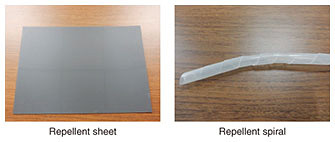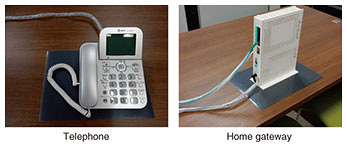 |
|||||||
|
|
|||||||
|
Practical Field Information about Telecommunication Technologies Vol. 17, No. 8, pp. 20–23, Aug. 2019. https://doi.org/10.53829/ntr201908pf1 Countermeasures against Insect Damage to User Equipment—Repellent Sheet and Repellent SpiralAbstractTelecommunication equipment can malfunction if it is damaged by insects. It is therefore necessary to develop measures to prevent such damage. This article presents examples of the damage that can occur when cockroaches nest inside equipment and introduces two products designed to stop them from accessing the equipment. This is the fifty-third article in a series on telecommunication technologies. Keywords: insect damage, repellent, cockroach 1. IntroductionTelecommunication equipment is installed in various environments, and it therefore must coexist with any creatures living there. Equipment installed outdoors or at a customer’s premises is usually exposed to living things, and that exposure often leads to damage to the equipment. This report introduces the characteristic damage that occurs to telephones and communication equipment such as home gateways caused by insects such as cockroaches—about which the Technical Assistance and Support Center has received many inquiries from all over the country—and describes our countermeasures against such damage. 2. Characteristics of damage due to cockroachesIf cockroaches invade and nest inside communication equipment such as a telephone and home gateway at a customer’s premises, they may chew the substrate and wiring, or their habitation may cause a malfunction such as substrate shorting due to their excrement (Photo 1). In the field, although the equipment can be repaired or replaced, if the surrounding environment does not change, it is likely that the cockroaches will crawl into and nest in repaired or new equipment again and again, and the malfunctions will keep reoccurring.
The results of investigations into the cause of malfunctions that occurred due to cockroaches revealed that the intruding cockroaches are 3 to 12 mm in length. Their brown body and pale back led to the conclusion that they are the species called German cockroaches (Blattella germanica) [1]. The German cockroach inhabits all regions of Japan and prefers warm and dark places; accordingly, it is often found in air-conditioned environments such as restaurants. Since the interior of communication equipment is always warm and dark, it is considered a convenient environment for the cockroaches to nest in. Previous measures against cockroach damage involved asking customers to remove the cockroaches and block places that serve as cockroach entrances to communication devices. However, such countermeasures were difficult to implement since radical extermination was difficult, and not all entry points to the equipment could be closed off. 3. New countermeasures based on insect repellentIn the meantime, the Technical Assistance and Support Center has been examining damage to access equipment caused by insects such as ants. We have also been collaborating with pharmaceutical companies to promote measures to prevent such damage. These measures include producing a type of tape that contains a repellent composed primarily of a pyrethroid*1, which has a repellent effect against insects (Photo 2).
Damage by ants to access equipment was mainly caused by ants nesting in the optical closures of overhead equipment. The ants often chewed through optical-fiber core wires inside core-wire housings, disconnecting them (Photo 3). Moreover, inside metal terminal boxes, the ants chewed the outer sheaths of the core wires. The effect of formic acid*2 caused the core wires to come into contact with each other, and that contact caused insulation failure (Photo 4). Implementing measures using repellent tape makes it possible to prevent ants nesting in optical closures and metal terminal boxes (Photo 5).
As a result of the examinations described above, we devised a repellent sheet and a repellent spiral—both of which use the same repellent agent—as a new countermeasure against cockroach damage (Photo 6). The repellent sheet is an A4-size sheet that has a repellent coated on its surface. The sheet is placed under communication equipment to stop cockroaches entering from the bottom of the equipment. The repellent sheet has a three-layer structure consisting of repellent, polyester sheet (semi-transparent), and non-slip coating. As well as having a repellent effect, the non-slip coating prevents movement of the sheet while the equipment is in use.
The repellent spiral is made of a polyester material, with repellent agent applied to the inner and outer surfaces of the spiral. This prevents insects from invading communication equipment via electrical cables. The spiral has an inner diameter of 12 mm and a length of about 30 cm. It is simply wrapped around power supply cords, local area network cables, and the like. The repellent sheet can simply be placed under the main units of communication equipment, and the repellent spiral can simply be wrapped around power supply cords and cables by workers in a quick and easy manner (Photo 7). Moreover, the period during which the repellent effect of these countermeasure products lasts is about 10 years (for equipment installed in dark places). Although it is necessary to avoid exposure of these products to direct sunlight since ultraviolet (UV) rays reduce the repellent effect, we know that about 80% of the insect-repellent effect is maintained after two years if the usage environment is under UV light at the level produced by indoor fluorescent light.
4. Verification of effectiveness of countermeasuresWe conducted the following experiment in collaboration with a pharmaceutical company in order to evaluate the repellent effect of the repellent sheet and the repellent spiral in relation to cockroaches. A phone fitted with both the sheet and the spiral and a phone without either of them were set up in a large case used for the experiment. About 50 cockroaches were left in the test case for six days, after which we checked whether any cockroaches were nesting in either of the phones. The result of this experiment was that after six days, cockroaches had invaded and nested in the phone without the repellent products; in contrast, no cockroaches had nested inside the phone fitted with the products. We also implemented the countermeasures in the following example of an on-site application. In this example, cockroaches had intruded into a telephone installed in a restaurant, and the phone had repeatedly malfunctioned due to cockroach damage. At the restaurant, there were regular incidents of the phone malfunctioning (about once every three months) and not being able to be used. The phone was replaced after each incident. The malfunctions were later found to be due to cockroach damage. Consequently, the Technical Assistance and Support Center received a request to conduct research on biological damage to equipment and countermeasures against such damage. We then decided to implement countermeasures at the restaurant using the repellent sheet and repellent spiral. First, to prevent cockroaches getting into the phone, we installed the repellent sheet under the phone and attached the repellent spiral to the cables connected to the phone. At this writing, it has been about six months since the countermeasures were implemented, and the phone has not malfunctioned since then. We thus believe that it will be possible to prevent cockroaches nesting inside phones by applying these countermeasures in the future. We are currently working on the commercialization of these countermeasures as products that can also be purchased by companies outside the NTT Group that construct telecommunication facilities. 5. Concluding remarksThis report focused on biological damage to user equipment and specifically introduced measures to prevent damage caused by cockroaches. These countermeasures are easy to implement and are expected to help our customers reduce such damage in the field. The Technical Assistance and Support Center, including our predecessor the Technical Cooperation Department, has provided on-site assistance through technical cooperation activities for over 50 years. We will continue to apply the knowledge and experience we have accumulated so far as well as to develop new technologies in our efforts to reduce the number of malfunctions that occur and improve the reliability of communication equipment. Reference
|
|||||||















